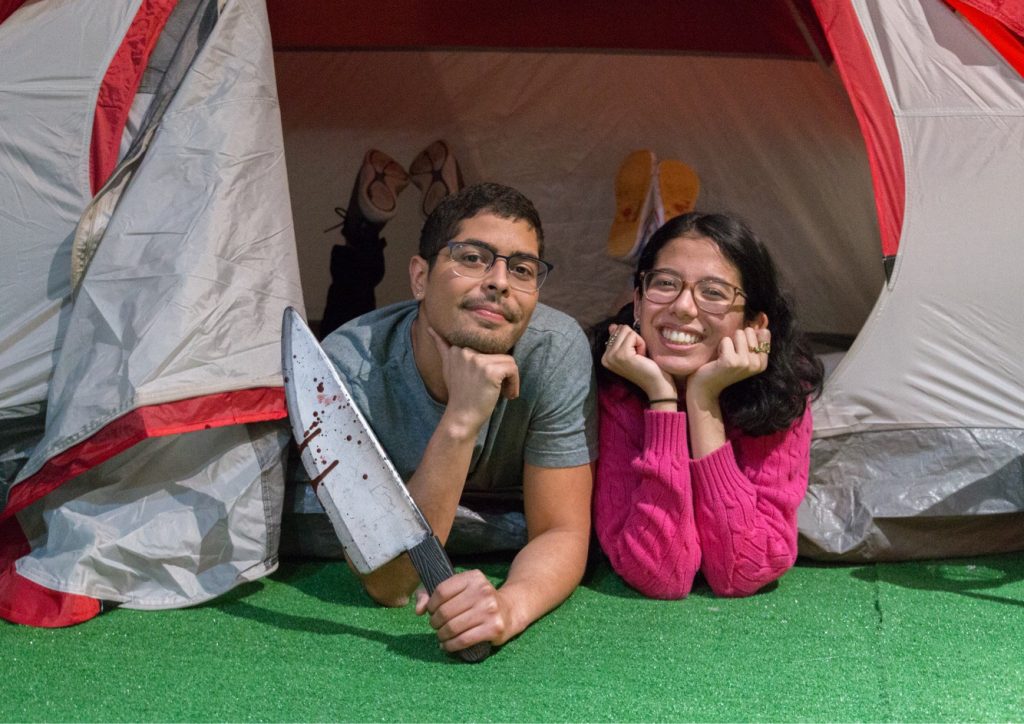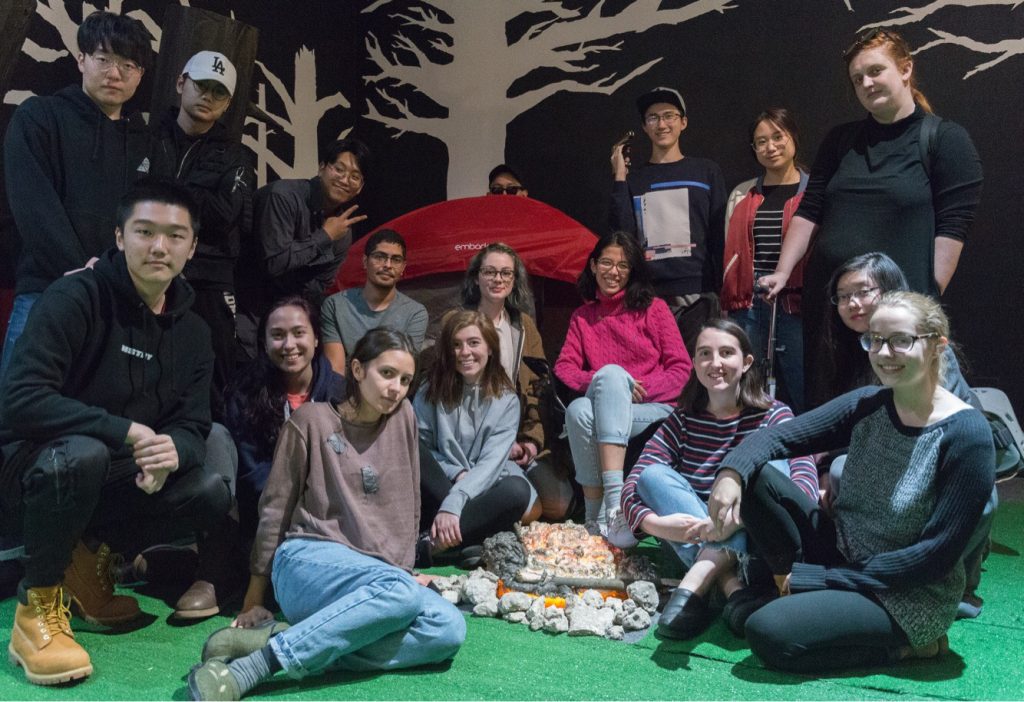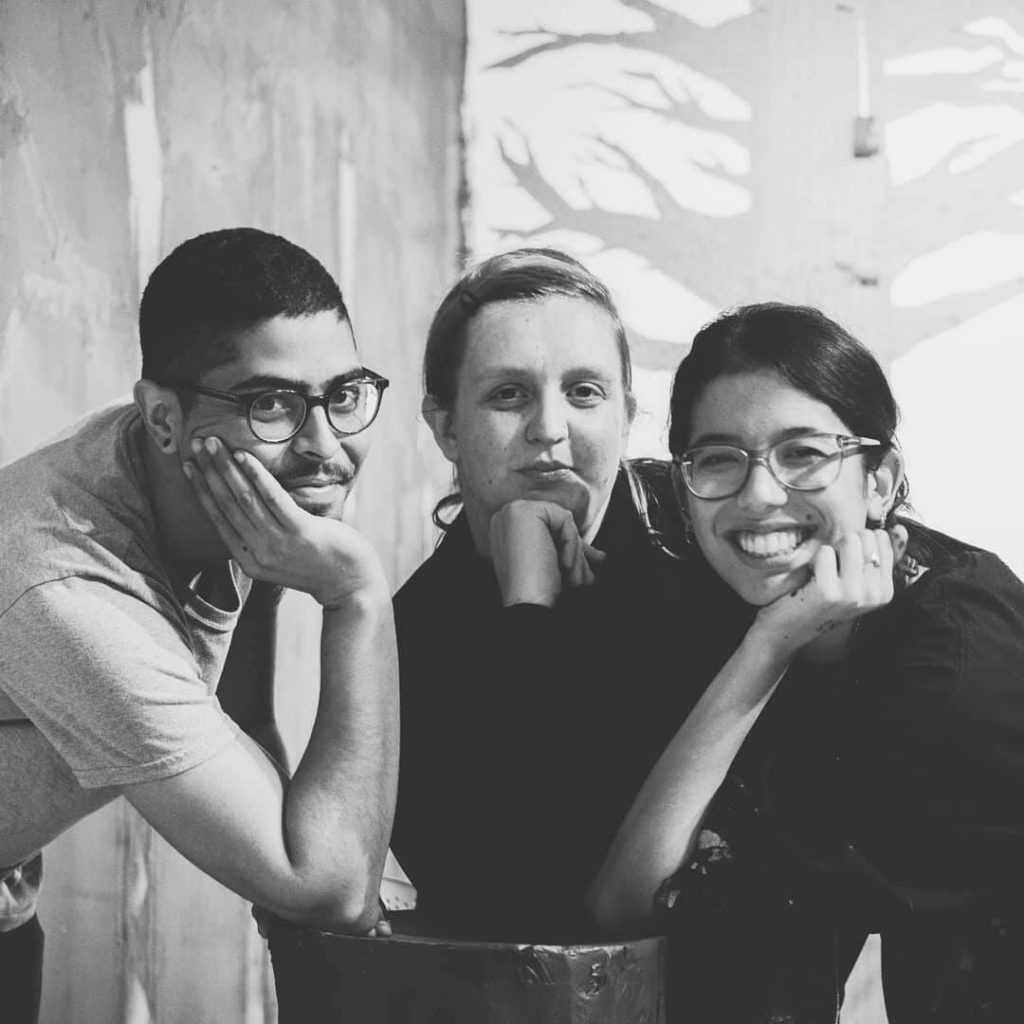
Student Spotlight: Rana Liu

The Final Trope is an immersive art installation at the Hokin Gallery that opened on October 29, 2018. Curated by Owen Rodriguez, this exhibit features a collection of horror movie histories, intertwining the concept of horror movie tropes and cliches. The exhibit follows a group of five characters that lead to different rooms to shed light–and blood–on these concepts.
Rana Liu is a second-year graduate student in the Master of Arts Management program at Columbia. Read more about The Final Trope and how a bloody, scary genre evolved into a successful art exhibit.
What is The Final Trope, and how did you get involved?
This isn’t your everyday exhibit. Following Owen’s vision, we first built a film set in the Hokin Gallery, where we then filmed his and [director] Jeffrey Sweeney’s horror movie. We then converted the film set into an exhibition. This is the first time that the Hokin Gallery has undergone such an extensive transformation, from white walls into a horror campsite cabin!
I got involved in this project because Bob [Blandford, Gallery Management practicum professor] approached me this summer when I was working at the BUSE office as a Graduate Assistant. He knew I was taking his class in the upcoming semester and pitched me Owen’s exhibition. Soon after, I met up with Owen, and we hit it off right away. I was then brought on as the project director in late August of this year.
How do you think working on this exhibit has helped you build your professional skills for the future?
For each exhibit, a graduate student is assigned a higher managerial position where Bob acts as a mentor to the student. This structure allows graduate students to take on a leading role, where they have more freedom and also more responsibility in the practicum to run an exhibition. I have found that having the support of an experienced academic member has widely contributed to advancing my managerial skills this semester. Not to mention, I have also been applying the knowledge I have learned from my previous classes in the MAM program into this practicum. From implementing production calendars and creating marketing plans to ensuring a positive workflow during our exhibition building process, honestly, there is never a dull moment in this practicum.

What makes the horror genre unique as subject for an art exhibition?
Horror is such a peculiar genre that is often overlooked for its in-depth perspective on societal norms. Because of the intense emotions that are brought out through the horror genre, many disregard the fact that this genre actually analyzes societal issues through a magnified lens. Horror is bloody scary (literally and figuratively), and many can’t look past that aspect. By deconstructing the genre of horror, this art exhibition allows audience members to see beyond the gore, and appreciate the mirroring of the tropes to society’s stereotypes.
Why does the exhibit focus on 80’s-style horror and not another era?
Many of the classic horror movies that shaped the genre are from the 1980s. A Nightmare on Elm Street (1984), The Shining (1980), The Evil Dead (1981), Hellraiser (1987), Friday the 13th (1980), and Fright Night (1985) are all examples of the perfect horror movie. This era established the five tropes that are now synonymous with the genre, where: the minority dies first; then the cheerleader and jock; followed by the scholar; and leaving the final girl standing. Owen Rodriguez, the curator of the show, was inspired to create this exhibition because of his love for this era of film and the aesthetic linked to it.
As the project director forThe Final Trope, what are you hoping audiences, and Columbia students in particular, will take away from the exhibition?
There are two takeaways that I’d like people to walk away with after leaving the exhibition:
One: f*** societal norms! Do whatever pleases you. Do not let others box you in. I hope that people analyze these five tropes and reflect on why these are the five stereotypes that are ingrained in the horror genre. Society has constructed these standards, boxing people in regarding their gender, sexual orientation, race, age, beliefs – labelling and objectifying people. Now more than ever, we need to educate ourselves and change these toxic stereotypes. I always joke that I am all five tropes. Now where would that place me in the horror film? Because of my ethnicity, will I be gone first? Or because I enjoy to be intellectually stimulated, that makes me go last? This exhibition is created to make people question themselves and the society we live in. We want to disrupt the conventional and make people walk away with a more open and curious mind. The Final Trope isn’t going to change the world, but it will definitely change the way people think, allowing us to get one step closer to having a more peaceful and loving society accepting of all.
Two: You can create anything you want. If you have a dream, don’t just sit there passively and wait for it to just happen. Make it happen. Nothing is stopping you. Need resources? Go and apply for a grant, crowdsource. Need people? Go and ask for help. The only person stopping you is yourself. You can do anything you set your mind to.

What are some benefits and challenges of hosting an exhibition versus a performance, live event, etc.
I come from a theatre background, where so much rides on live performances. From an actor getting sick, or a set piece breaking during the show, there are many aspects of a live performance you can’t control. You can prepare as much as you can in advance, but many times life just happens! Many of these elements do bleed into hosting an exhibition, since you want opening night to go flawlessly, ensuring that none of the technical equipment breaks. Not to mention, attendance numbers, timetables and budget retrains are all challenges also found in hosting an exhibition. However, in a gallery setting, it is much more controlled. As soon as the exhibition is set and in place, a huge stress is loaded off, unlike in theatre, where every performance has its own quirks. The biggest benefit is probably how controlled you can have the educational aspect of a show. In an exhibition one can provide plenty of information and data, while at times in live performances it can be more up to interpretation because there isn’t as much concrete information that can be read, apart from the playbill.
What is your favorite 80’s horror movie, and why?
This is embarrassing but I am absolutely terrified of horror movies. BUT if I were to have a favorite (according to The IMDb descriptions) I would say The Shining. The plot is so interesting, it’s extremely aesthetically pleasing, and Jack Nicholson is an absolute beast of an actor.
You can visit The Final Trope Exhibition at Hokin Gallery at 623 S Wabash, 1st floor, Chicago IL 60605.
Exhibition runs from October 29th, 2018-January, 2019.
Gallery Hours: Monday-Friday 9 a.m.-10 p.m., Saturday 8 a.m. – 6 p.m.
For more information on The Final Trope, visit:
https://thefinaltrope.wordpress.com